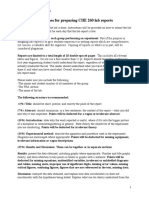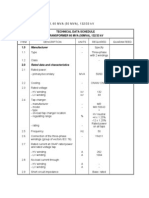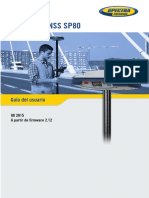CE 330 Lab Report Format
CE 330 Lab Report Format
Uploaded by
Bianca GonzalesCopyright:
Available Formats
CE 330 Lab Report Format
CE 330 Lab Report Format
Uploaded by
Bianca GonzalesOriginal Title
Copyright
Available Formats
Share this document
Did you find this document useful?
Is this content inappropriate?
Copyright:
Available Formats
CE 330 Lab Report Format
CE 330 Lab Report Format
Uploaded by
Bianca GonzalesCopyright:
Available Formats
UNIVERSITY OF HAWAII AT MANOA Department of Civil & Environmental Engineering CEE 330 - Environmental Engineering
LABORATORY REPORT FORMAT General information: All laboratory reports must be typed (double-spaced) to be accepted. All reports must be completed in order to pass the course. Reports received after the stated due-date will be penalized 10% per day late. Spelling, grammar, and style are important considerations in the report grading scheme. Completeness, accuracy, and brevity are essential. The goal of the reports and instructor feedback is to help the students improve their writing skills. You will turn in five individual reports. Two of the reports will be full-length and three will only include an executive summary. Reports for pH/Alkalinity, Phosphate, and Coliform Bacteria will be executive summary only. Reports for Suspended Solids and BOD will be full-length plus executive summary. The full length reports will be submitted, graded, revised, and resubmitted for final grading. Steps: 1) Student prepares report in final draft quality and includes a filled out checklist on Grading Rubric & Self Evaluation sheet, 2) Instructor reviews draft report and returns report with comments as well as draft score on Grading Rubric & Self Evaluation sheet, 3) Students revise reports incorporating suggestions, fill out self-evaluation of report and revisions, and turn in final report, 4) Instructor completes Grading Rubric with final score. Specific information: Each report should include the following sections: 1. 2. 3. Title Page. This page should include the report title, your name, your group member's names, the name of the class, and the date. Objective. Briefly state the purpose of the experiment including the experimental values that will be measured and/or determined and for what samples. Should not exceed two or three sentences. Introduction. This is an important section and sets the tone for a good report/paper or a mediocre one. This section should explain the relevance of the method performed and the parameters determined. You should establish a link between the parameters studied and their importance to practical application in the "real world." To what process(es) and environment(s) does the parameter most commonly apply (i.e. wastewater, natural water, drinking water, etc.) and what are typical and expected values? What are the regulations for this parameter? Discuss theory of method (how it works, what reacts to form what). Method. This section should include the steps performed in the experiment in a "bullet" list format. Try to isolate all specific steps and routine quantities but keep is simple. You must refer to the Standard Method (i.e. Method No. 2540 D). List equipment used (number, size, model #, etc.). Show the equations used. Show/explain the detection limits of the methods. Include either photos or drawings of equipment/apparatus. Data and Results. Summarize the data obtained during the experiment in tables. Do not forget to include units for all quantities. Provide all calculated results (including intermediate calculated values) in tables and/or graphs. Be sure to use the correct number of significant digits (based upon detection limits). Discussion and Conclusions. Describe the key results in sentence format. Did the analyses result in the quantities that you expected? If duplicates or triplicates were measured for the same sample, calculate statistics and compare and discuss any discrepancies. Compare your results with typical/expected values and regulations. Are the results acceptable/normal for the type of sample?, are the regulations met? Briefly discuss potential causes for inaccuracy/error in the results (and expected magnitude), or deviations from the standard protocol of the analyses. Appendix I: This should include all relevant formulas and sample calculations. Show each calculation once. This should be written by hand. Appendix II: This should include a photocopy of the original, dated sheet(s) that you recorded your data on at the time of performing the experiment. This is an important reference for identifying miscalculations, etc.
4.
5.
6.
7. 8.
Executive summaries: An executive summary must be limited to one page, single-spaced. It includes a brief description of the objective, the relevance of the analysis (why it is important), the methods used, typical values and regulations, the results (but no tables or raw data), and a detailed discussion of the conclusions. The Executive summary contains all of the necessary information for an executive (who may not be familiar with the experiment) to make a decision based upon a convincing and logical discussion of the findings.
You might also like
- Laboratory Report Guidelines JKUAT UndergraduateDocument3 pagesLaboratory Report Guidelines JKUAT UndergraduateDECENT DECENT MUSINAINo ratings yet
- Pole Line Hardware JoslynDocument140 pagesPole Line Hardware Joslynsalvandy100% (1)
- Physics Lab Report Example PDFDocument17 pagesPhysics Lab Report Example PDFFara Diba100% (1)
- Hegner Manual PDFDocument19 pagesHegner Manual PDFOsairManassan0% (3)
- Annual Maintenance Contract (English)Document9 pagesAnnual Maintenance Contract (English)Ketaki SomanNo ratings yet
- Formal Lab Report GuideDocument7 pagesFormal Lab Report Guidebrxhpk6j7jNo ratings yet
- Guidance For Writing Lab ReportsDocument31 pagesGuidance For Writing Lab ReportsMehdi Chames Eddinne LAYESNo ratings yet
- Guidance For Writing Lab ReportsDocument31 pagesGuidance For Writing Lab Reportsalawi1889No ratings yet
- (CEAC Y2 Chem Eng Labs) Gas Absorption - Assessment GuidelinesDocument4 pages(CEAC Y2 Chem Eng Labs) Gas Absorption - Assessment GuidelinesnoorNo ratings yet
- 155 Laboratory Syllabus 2015Document16 pages155 Laboratory Syllabus 2015Nguyen Viet HungNo ratings yet
- Tech Report NewDocument6 pagesTech Report NewKarim RazNo ratings yet
- Report Format IndustrialDocument9 pagesReport Format IndustrialBAG2989No ratings yet
- PHYS LAB REPORT FORMATDocument7 pagesPHYS LAB REPORT FORMATchikotibartholomewpatrickNo ratings yet
- CHE 260 Lab Report GuidelinesDocument3 pagesCHE 260 Lab Report GuidelinesJulianneNo ratings yet
- Garcia-Eapp 20241113 213115 0000Document11 pagesGarcia-Eapp 20241113 213115 0000nonatolyka75No ratings yet
- Lab Manual Mechanic of Materials SEM 2 20132014Document65 pagesLab Manual Mechanic of Materials SEM 2 20132014saruwatari michiyo100% (1)
- HSN204 Assessment 2 - Help Guide - Lab Report 1 and 2Document3 pagesHSN204 Assessment 2 - Help Guide - Lab Report 1 and 2Tommy CharlieNo ratings yet
- Bche Lab Manual 1Document121 pagesBche Lab Manual 1H.J.PrabhuNo ratings yet
- Lab Report Importance and FormatDocument4 pagesLab Report Importance and FormatAziz SomroNo ratings yet
- Author GuidelinesDocument6 pagesAuthor Guidelinesamril wijayaNo ratings yet
- Fluid Mechanics Lab ManualDocument16 pagesFluid Mechanics Lab ManualnidhalsaadaNo ratings yet
- DocumentDocument7 pagesDocumentfarazyousaf769No ratings yet
- Memd221 Lab Manual Sem 2 2015 2016Document64 pagesMemd221 Lab Manual Sem 2 2015 2016Harith ImranNo ratings yet
- Sample-lab-reportDocument18 pagesSample-lab-reportkuynakuluchoNo ratings yet
- Laboratory 01 - ES TemplateDocument3 pagesLaboratory 01 - ES TemplateNoreen BoncalesNo ratings yet
- BB_CHM1010_F24_formal lab report guidelines (1)Document3 pagesBB_CHM1010_F24_formal lab report guidelines (1)oliviaseptember2005No ratings yet
- Syllabus EMAE 285 Mechanical Engineering Measurements LaboratoryDocument4 pagesSyllabus EMAE 285 Mechanical Engineering Measurements Laboratorybuzzboy3002No ratings yet
- Guideline For Full-Length Report WritingDocument4 pagesGuideline For Full-Length Report WritingjohnNo ratings yet
- General Information For Authors: 2. Materials and MethodsDocument2 pagesGeneral Information For Authors: 2. Materials and MethodsSantosh ReddyNo ratings yet
- Report Writing GuidelinesF17Document8 pagesReport Writing GuidelinesF17humaboutNo ratings yet
- A Guide To Physics Laboratory Report WritingDocument7 pagesA Guide To Physics Laboratory Report WritingKorir BrianNo ratings yet
- Guidelines for Physics Lab Reports (updated)Document3 pagesGuidelines for Physics Lab Reports (updated)EvilMrGuiNo ratings yet
- ALL ABOUT THE IAsDocument36 pagesALL ABOUT THE IAsshdhdhNo ratings yet
- IB LabReport PDFDocument4 pagesIB LabReport PDFMalak Abu SharkhNo ratings yet
- Balancing of Rotors: 1. ResultsDocument1 pageBalancing of Rotors: 1. ResultshenryNo ratings yet
- Fluids Mechanics Lab ManualDocument30 pagesFluids Mechanics Lab ManualHaseen KaurNo ratings yet
- 2025 LAB REPORT FORMATDocument3 pages2025 LAB REPORT FORMATseruethan20No ratings yet
- MEMB221 Lab ManualDocument66 pagesMEMB221 Lab ManualRynda BlyndaNo ratings yet
- 01 How To Write An IB Science Lab ReportDocument5 pages01 How To Write An IB Science Lab ReportWisaruth MaethasithNo ratings yet
- IB Chemistry - How To Write A Lab Report: GeneralDocument3 pagesIB Chemistry - How To Write A Lab Report: GeneralNikos PapaioannouNo ratings yet
- Engineering Report Guide UFLDocument21 pagesEngineering Report Guide UFLAndreGachetteNo ratings yet
- Final Version of LabReportTemplateDocument8 pagesFinal Version of LabReportTemplatePorkkodi SugumaranNo ratings yet
- CHM 2330 General Lab Information-2025Document9 pagesCHM 2330 General Lab Information-2025fatma abdoNo ratings yet
- Long Report FormatDocument5 pagesLong Report FormatMUHAMMADZULFIQAR67% (3)
- Lec 5Document13 pagesLec 5utindelNo ratings yet
- MCB 3020L Lab Report Guidelines-1Document5 pagesMCB 3020L Lab Report Guidelines-1AWEDNo ratings yet
- Lab Report Guidelines For IB BiologyDocument4 pagesLab Report Guidelines For IB BiologyDAN DNANo ratings yet
- Guide For Writing Laboratory Reports - 2021Document7 pagesGuide For Writing Laboratory Reports - 2021Hussain Ali MurtazaNo ratings yet
- Research Plan Format For Engineering Design ProjectsDocument5 pagesResearch Plan Format For Engineering Design ProjectsAnton Colasi CorulloNo ratings yet
- Machine Design and CAD Lab ManualDocument45 pagesMachine Design and CAD Lab ManualPraviin Jayakumar100% (3)
- MECE3360 SyllabusDocument6 pagesMECE3360 SyllabusVanessa JaramilloNo ratings yet
- Full Report GuidelinesDocument4 pagesFull Report GuidelinesGabriel Michaud-VerreaultNo ratings yet
- Criteria For Writing A Formal Lab Report (Spring 2023) - 1Document5 pagesCriteria For Writing A Formal Lab Report (Spring 2023) - 1omar.abudiab64No ratings yet
- Title of Lab: Abstract (Maximum Page)Document2 pagesTitle of Lab: Abstract (Maximum Page)henryNo ratings yet
- Heat Transfer Lab Manual-2014Document27 pagesHeat Transfer Lab Manual-2014thobyyNo ratings yet
- Polymer Processing Design LaboratoryDocument38 pagesPolymer Processing Design LaboratoryAbdul Rahman0% (1)
- Report Writing 8Document3 pagesReport Writing 8sajjad_naghdi241No ratings yet
- Guide-to-Laboratory-Report-WritingDocument2 pagesGuide-to-Laboratory-Report-Writingephremtaye24No ratings yet
- Sci. Mat. Lab Script 2013-2014 From Allan Edited AM PDFDocument29 pagesSci. Mat. Lab Script 2013-2014 From Allan Edited AM PDFAPNo ratings yet
- Statistics at Square Two: Understanding Modern Statistical Applications in MedicineFrom EverandStatistics at Square Two: Understanding Modern Statistical Applications in MedicineNo ratings yet
- PLD-ADM - Mercedes Benz Pages PDFDocument92 pagesPLD-ADM - Mercedes Benz Pages PDFEbercito Tu Pc Granados AguirreNo ratings yet
- 4.5.5-3 Internal - Audit ChecklistDocument6 pages4.5.5-3 Internal - Audit ChecklisthamidNo ratings yet
- System - IO.Ports: //create A Serial Port ObjectDocument8 pagesSystem - IO.Ports: //create A Serial Port ObjectQuốc Sự NguyễnNo ratings yet
- COMBINED Elo Kitchen Armor All in One Spec SheetsDocument8 pagesCOMBINED Elo Kitchen Armor All in One Spec SheetsArmando MendesNo ratings yet
- Repco Bank 148 Clerk Vacancies-GovtjobsdailyDocument10 pagesRepco Bank 148 Clerk Vacancies-GovtjobsdailygovtjobsdailyNo ratings yet
- Informative Speech Assessment Assignment Instructions 2020-21Document2 pagesInformative Speech Assessment Assignment Instructions 2020-21erieruiwerNo ratings yet
- ProNautic ManualDocument9 pagesProNautic ManualJose CandedoNo ratings yet
- Week 5 Unit9 English For ItDocument8 pagesWeek 5 Unit9 English For Itapi-262133173No ratings yet
- BS en 171 Ir FiltersDocument17 pagesBS en 171 Ir FiltersallanfosterNo ratings yet
- Sanitory Works SpecDocument10 pagesSanitory Works SpecCyril J PadiyathNo ratings yet
- UntitledDocument254 pagesUntitledmegamaster0987654321No ratings yet
- Zend Framework Cheat SheetDocument1 pageZend Framework Cheat Sheet高巍No ratings yet
- CAT Front Shovel 385CDocument16 pagesCAT Front Shovel 385CCraciun AndreiNo ratings yet
- Concrete Inspection & Metal DetectionDocument13 pagesConcrete Inspection & Metal DetectionSupriyo PNo ratings yet
- Annex 1 - Technical SpecificationsDocument197 pagesAnnex 1 - Technical SpecificationsmanojNo ratings yet
- Embedded System Development Coding Reference GuideDocument190 pagesEmbedded System Development Coding Reference GuideDucSyHo100% (1)
- CS438 Midterm SolDocument6 pagesCS438 Midterm SolDavide SlanziNo ratings yet
- Credo BrochureDocument17 pagesCredo BrochuredediodedNo ratings yet
- IsDB - Sample of Standard Evaluation Report For Selection of Consultants - March 2015Document30 pagesIsDB - Sample of Standard Evaluation Report For Selection of Consultants - March 2015Alessandra Mae SalvacionNo ratings yet
- AIRSUN Presentation English VersionDocument34 pagesAIRSUN Presentation English VersionPennyNo ratings yet
- Amit Nayak Resume - Technical Lead Piping - 07.12.23Document5 pagesAmit Nayak Resume - Technical Lead Piping - 07.12.23Sumantra ChattopadhyayNo ratings yet
- DevlistDocument9 pagesDevlistasdxzqwNo ratings yet
- Configuration Examples For IOS SLBDocument65 pagesConfiguration Examples For IOS SLBPeter MkamaNo ratings yet
- Basic Firewall TroubleshootingDocument4 pagesBasic Firewall TroubleshootingAsifNo ratings yet
- Certified International Procurement Professional - IndiaDocument4 pagesCertified International Procurement Professional - IndiaapdesepedaNo ratings yet
- Large Touch Screen Interface Fully Integrated DICOM: Captus 4000e ReportsDocument2 pagesLarge Touch Screen Interface Fully Integrated DICOM: Captus 4000e ReportsAntony SantosNo ratings yet
- Guia de Usuario GPS Spectra SP80 PDFDocument118 pagesGuia de Usuario GPS Spectra SP80 PDFAlbrichs BennettNo ratings yet

























































































